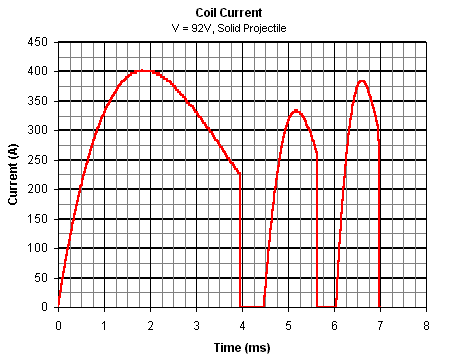|
Electromagnetic Pistol:
CS-P01A
Testing Area - accelerator
Performance (2)
Accelerator
Performance on a capacitor source -
In these tests
the accelerator was fitted with the pistol prototype MOSFET array consisting of three
blocks of four paralleled IRF3415 devices. Fig 1 shows the accelerator setup in the
test rig.
Fig
1. Subsystems connected for capacitor test firing.
The prototype MOSFET
array is shown in fig 2. The tabs of the T0-220 package were cut off due to height
restrictions inside the gun. During one of the test firings the projectile jammed
in the stage-1 section of the accelerator allowing a larger current pulse than usual
- it was enough to blow one of the PCB tracks to the MOSFET block. This component
will need a bit of redesign.
Fig
2. MOSFET array.
Fig 3 illustrates
the capacitor current as measured in the 0 V return line. This measurement doesn't
show the commutation current in the coils after the MOSFETS turn off. The current
measuring sensor is a commercial 0.01 resistive element. It is mounted in a small plastic box with a BNC output connector.
resistive element. It is mounted in a small plastic box with a BNC output connector.

Fig
3. Capacitor discharge currents
Table 1 gives the
data from test firings with a solid projectile using 1, 2 and 3 stages. The 'overall
efficiency' column refers to the efficiency of each stage - simply the gain in
projectile energy divided by the used energy (the capacitors don't fully discharge
so there is some 'residual' energy after firing). Again we can see that the efficiencies
of stages 2 and 3 are larger by a factor of about 4 over stage 1. This fact makes
it clear that an energy efficient coilgun will be a multistage device. Although
the latter stages are much more efficient, they process a significantly smaller
amount of energy than stage 1 therefore the total system efficiency is only around
4.7%. The specific distribution of energy in a multistage coilgun is probably
quite important in determining the resulting overall efficiency of the gun. This
is an aspect of coilgun behaviour that will be investigated for the design of
the coilgun rifle.
| Coil |
Speed (m/s) |
Energy Gain (J) |
Source Energy Transfer (J) |
Overall Efficiency (%) |
| 1 |
1.85E+1 |
2.14E+0 |
8.45E+1 |
2.53E+0 |
| 2 |
2.50E+1 |
1.77E+0 |
1.80E+1 |
9.8E+0 |
| 3 |
3.03E+1 |
1.83E+0 |
1.80E+1 |
1.0E+1 |
| ALL |
3.03E+1 |
5.74E+0 |
1.21E+2 |
4.7E+0 |
Table
1. Performance data.
After testing this
setup it was decided that the stage-1 MOSFET block needed six paralleled MOSFETS
to remain within the device thermal limits under repetitive firing.
|

